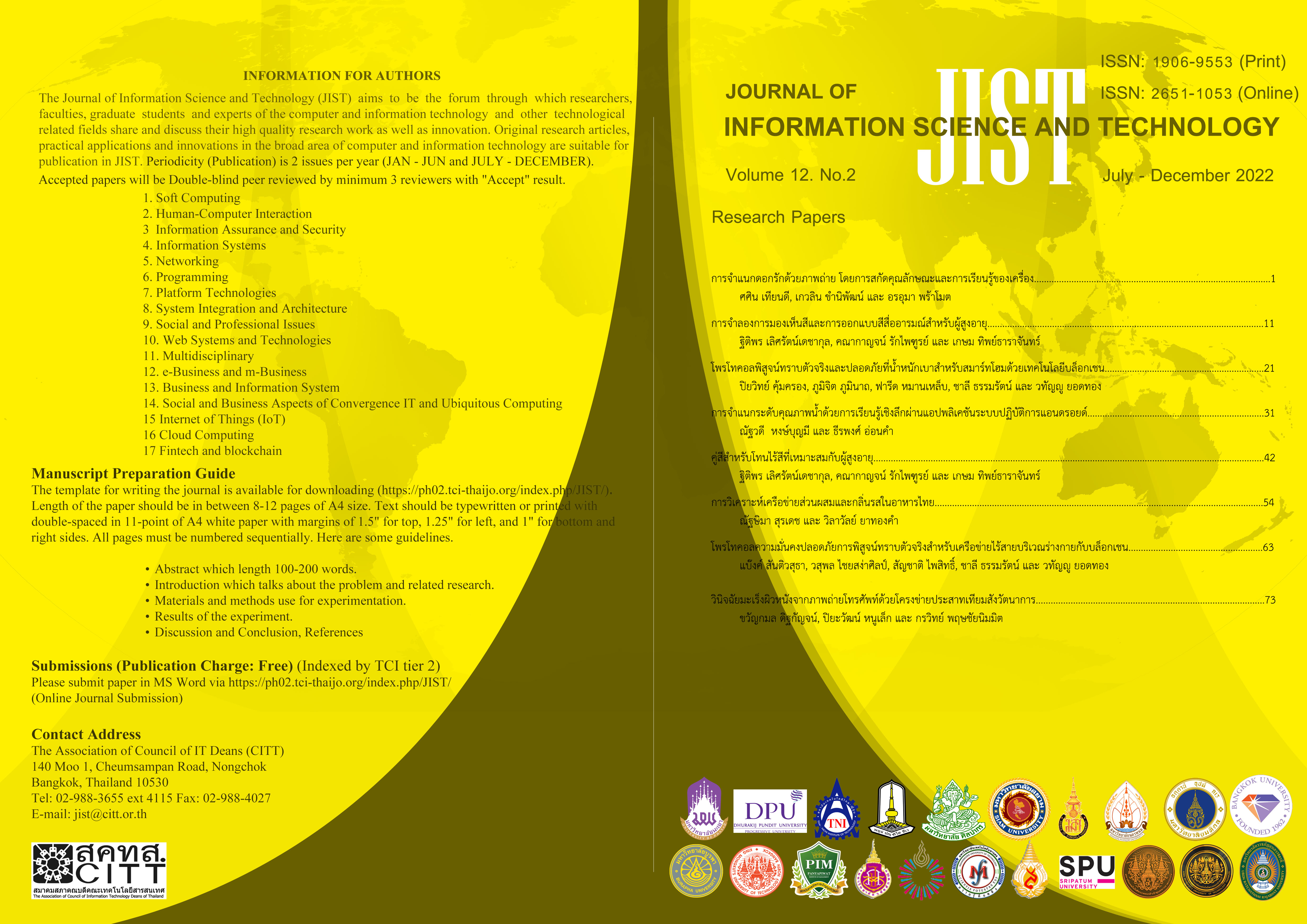Ingredient and Flavor Network Analysis in Thai Cuisine
Main Article Content
Abstract
Thai cooking places emphasis on a specific smell and taste of ingredients to create a different recipe based on the dish type. Moreover, the flavor is considered an important part that generates consumer satisfaction with the flavors in each dish. Therefore, this research aims to analyze the ingredient and flavor network in Thai cuisine. Statistical tools were used to carry out the study characterization of the cuisine and a flavor network was constructed to analyze the relationship between ingredients and flavor compounds. It was found that the flavor network of main dishes is different from dessert. In addition, most of the prevalent ingredients in the cuisine tend to share many flavor compounds. The frequency of ingredients used indicates a cooking style that corresponds to the unique taste of each dish type. This research will be useful to those who are interested in Thai dining for applying this finding to further research and development of food innovations in the field of flavor, recipes, or commoditization of new food products.
Article Details
This work is licensed under a Creative Commons Attribution-NonCommercial-NoDerivatives 4.0 International License.
I/we certify that I/we have participated sufficiently in the intellectual content, conception and design of this work or the analysis and interpretation of the data (when applicable), as well as the writing of the manuscript, to take public responsibility for it and have agreed to have my/our name listed as a contributor. I/we believe the manuscript represents valid work. Neither this manuscript nor one with substantially similar content under my/our authorship has been published or is being considered for publication elsewhere, except as described in the covering letter. I/we certify that all the data collected during the study is presented in this manuscript and no data from the study has been or will be published separately. I/we attest that, if requested by the editors, I/we will provide the data/information or will cooperate fully in obtaining and providing the data/information on which the manuscript is based, for examination by the editors or their assignees. Financial interests, direct or indirect, that exist or may be perceived to exist for individual contributors in connection with the content of this paper have been disclosed in the cover letter. Sources of outside support of the project are named in the cover letter.
I/We hereby transfer(s), assign(s), or otherwise convey(s) all copyright ownership, including any and all rights incidental thereto, exclusively to the Journal, in the event that such work is published by the Journal. The Journal shall own the work, including 1) copyright; 2) the right to grant permission to republish the article in whole or in part, with or without fee; 3) the right to produce preprints or reprints and translate into languages other than English for sale or free distribution; and 4) the right to republish the work in a collection of articles in any other mechanical or electronic format.
We give the rights to the corresponding author to make necessary changes as per the request of the journal, do the rest of the correspondence on our behalf and he/she will act as the guarantor for the manuscript on our behalf.
All persons who have made substantial contributions to the work reported in the manuscript, but who are not contributors, are named in the Acknowledgment and have given me/us their written permission to be named. If I/we do not include an Acknowledgment that means I/we have not received substantial contributions from non-contributors and no contributor has been omitted.
References
กอบแก้ว นาจพินิจ, อาหารไทย โครงการตำราวิชาการราชภัฏเฉลิมพระเกียรติ, กรุงเทพฯ: เสมาธรรม, 2542.
อรไท สวัสดิชัยกุล, “ชีวเคมีของพริก ตอนที่ 2 ว่าด้วยเรื่องของกลิ่น,” วารสารอาหาร, ปีที่ 46, ฉบับที่ 1, หน้า 21-26, มกราคม-มีนาคม 2559. [ออนไลน์]. เข้าถึงได้: https://kukr2.lib.ku.ac.th/kukr_es/bkn/search_detail/dowload_digital_file/20010323/159215. [เข้าถึงเมื่อ 3 มีนาคม 2565].
กาญจนา มหัทธนทวี, “ความสาคัญของกลิ่นรสอาหารกับการตรวจวิเคราะห์กลิ่นอาหารโดยเทคนิค Gas Chromatography-Olfactometry (GC-O),” วารสารเทคโนโลยีการอาหาร มหาวิทยาลัยสยาม, ปีที่ 5, ฉบับที่ 1, หน้า 13-17, มิถุนายน 2552-พฤษภาคม2553. [ออนไลน์]. เข้าถึงได้: https://li01.tci-thaijo.org/index.php/JFTSU/article/download/38385/31804. [เข้าถึงเมื่อ 3 มีนาคม 2565].
นิธิยา รัตนาปนนท์, เคมีอาหารเบื้องต้น, กรุงเทพฯ: โอเดียนสโตร์,2563.
รัชนี ตัณฑะพานิชกุล, เคมีอาหาร, กรุงเทพฯ: มหาวิทยาลัยรามคำแหง, 2547.
Y. Y. Ahn,S. E. Ahnert, J. P. Bagrow, and A. L. Barabási,“Flavor network and the principles of food pairing,”Sci Rep,vol. 1, no. 1, pp. 1-7, Dec. 2011, doi: 10.1038/srep00196
V. Nedovic, “Learning recipe ingredient space using generative probabilistic models,” Proceedings of the 2nd Workshop Cooking with Computers, Beijing, China, August 3-5, 2013, pp. 11-16
J. Jermsurawong, and N. Habash, “Predicting the Structure of Cooking Recipes,” in Proceedings of the 2015 Conference on Empirical Methods in Natural Language Processing, Lisbon, Portugal, Sep. 17-21, 2015, pp. 781–786.
A. Jain, R. N K and G.Bagler, “Analysis of Food Pairing in Regional Cuisines of India,” PloS one,vol. 10, no. 10, pp. 1-17, Oct. 2015, doi: 10.1371/ journal.pone.0139539.
B. Khan, “Application of pattern mining on data of flavor molecules, their percepts and molecular features,” Ph.D. dissertation, Delhi: Indraprastha Institute of Information Technology Delhi, 2018
“Recipe,” FoodTravel.tv [Online].http://www.foodtravel.tv. (Accessed: Jan. 15, 2022)
N. Garg, et al., “FlavorDB: a database of flavor molecules,” Nucleic acids research, vol. 46, no. D1, pp. D1210–D1216, Oct. 2017, doi: 10.1093/nar/gkx957
กรมวิทยาศาสตร์บริการ, “เรื่องน่ารู้ของกลิ่นรสในอาหาร และเครื่องดื่ม,” ข่าววิทยาศาสตร์บริการ, มกราคม 2528. [ออนไลน์], เข้าถึงได้: http://lib3.dss.go.th/fulltext/dss_j/2528_107.pdf'. [เข้าถึงเมื่อ 23 มีนาคม 2565].
วันดี ณ สงขลา และวิบูลเพ็ญ ชัยปาณี, “วิธีปรุงอาหารไทย,” สารานุกรมไทยสำหรับเยาวชนฯ, มูลนิธิโครงการสารานุกรมไทยสำหรับเยาวชน โดยพระราชประสงค์ในพระบาทสมเด็จพระบรมชนกาธิเบศร มหาภูมิพลอดุลยเดชมหาราช, [ออนไลน์], 2532. เข้าถึงได้:https://saranukromthai.or.th/sub/book/book.php?book=13&chap=8&page=chap8.htm. [เข้าถึงเมื่อ 23 มีนาคม 2565].
Y. X. Zhu, J. Huang, Z. K. Zhang, Q. M. Zhang, T. Zhou and Y. Y. Ahn, “Geography and similarity of regional cuisines in China,” PloS one,vol. 8, no. 11, Nov. 2013, doi: 10.1371/ journal.pone.0079161
แววตา ชี้ทางดี และ สิรี ชัยเสรี. “ผลของอุณหภูมิและเวลาในการให้ความร้อนต่อปริมาณสารระเหยในใบเตย.” ใน การประชุมทางวิชาการของมหาวิทยาลัยเกษตรศาสตร์ ครั้งที่ 42, กรุงเทพฯ, 3-6 ก.พ. 2547, สำนักงานกองทุนสนับสนุนงานวิจัย, 2547. หน้า 542-549.
P. Shannon, et al., “Cytoscape: a software environment for integrated models of biomolecular interaction networks,” Genome research, vol. 13, no. 11, pp. 2498–2504, Nov. 2003, doi: 10.1101/ gr.1239303



